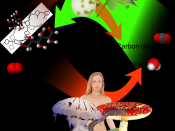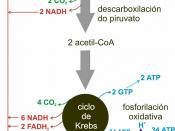Introduction
Aerobic respiration is the process by which mitochondria consume oxygen and organic fuel to produce ATP for the organism to use. Fermentation is another source of ATP for cells, but this method is by far, less effective in its yield of ATP. Glucose is the main source of organic fuel for cellular respiration, which releases as many as 38ATP molecules per glucose molecule in aerobic respiration. Unlike fermentation, which only releases 2 ATP molecules per glucose molecule.
The first step in the process of aerobic respiration is glycolysis, which produces two molecules of pyruvate per cycle using one glucose molecule. Pyruvate is then used in the Krebs cycle to release electrons in certain steps. These electrons then enter the electron transport chain where a series of steps produce the majority of the ATP formed during aerobic respiration.
Glycolysis takes place in the cytoplasm, while the other two steps occur within the mitochondrion organelle.
In order to study the reaction of aerobic respiration, a source of mitochondria is needed. Using a microcentrifuge, the mitochondria are removed from a solution of ground up lima beans. The mitochondria still carry out aerobic respiration even when they are removed from the rest of their cell contents. The source of glucose for this suspension is sucrose. Sucrose is processed readily by the mitochondria as it is a rich source of the sugar glucose.
To measure the rate of cellular respiration, you need to monitor the activity of enzymes in the system that are involved with the Krebs cycle. In one step, succinate is converted to fumarate. During this step, electrons are released from the reaction, which travel to the electron transport chain where they are used to make ATP.
In this experiment, DPIP is a blue dye used to indicate the presence and level...


